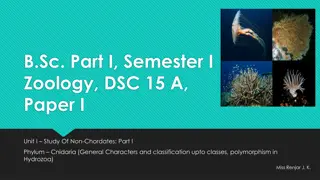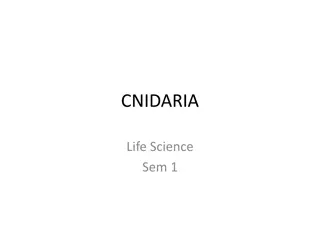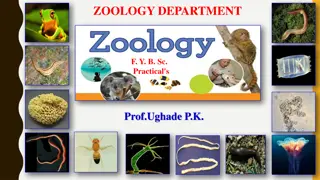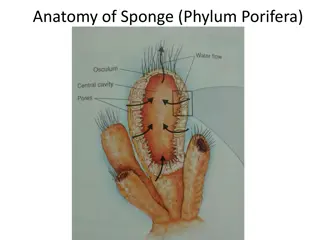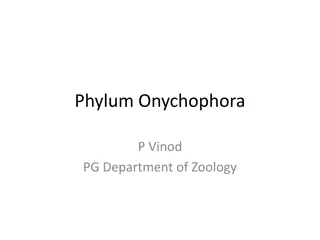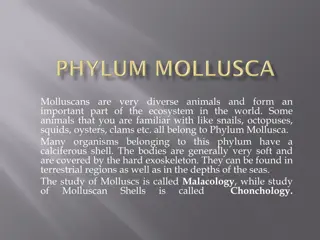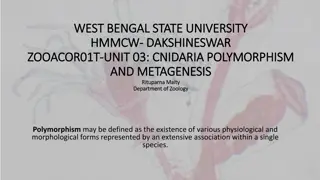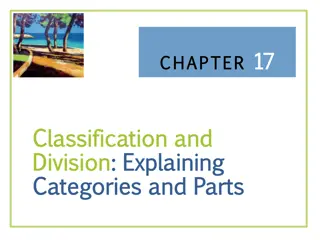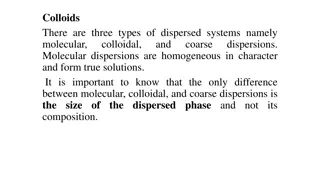Overview of Phylum Cnidaria: Classification and Characteristics
Phylum Cnidaria consists of around 10,000 species classified into 5 classes: Hydrozoa, Anthozoa, Cubozoa, Scyphozoa, and Staurozoa. Each class has unique characteristics and examples, such as the sea serpents in Hydrozoa and flower animals in Anthozoa. Cnidarians exhibit radial or biradial symmetry, and some classes have distinct features like cube-shaped medusae in Cubozoa. These marine organisms play vital roles in the ecosystem.
Download Presentation

Please find below an Image/Link to download the presentation.
The content on the website is provided AS IS for your information and personal use only. It may not be sold, licensed, or shared on other websites without obtaining consent from the author. Download presentation by click this link. If you encounter any issues during the download, it is possible that the publisher has removed the file from their server.
E N D
Presentation Transcript
CNIDARIA CNIDARIA
CLASSIFICATION OF PHYLUM CNIDARIA The phylum Cnidaria is represented by approximately 10,000 species. The phylum is classified into 5 classes. I. Hydrozoa (hydroids and siphonophores) II. Anthozoa (corals and sea anemone) III.Cubozoa (box jellyfish) IV.Scyphozoa (swimming jellyfish) V. Staurozoa (stalked jellyfish)
CLASS HYDROZOA (hydra= sea serpent and zoa= animal) These are called sea serpents because of numerous tentacles arising from their main body part. These are small, predatory animals which may live solitary or colonial. Most of the species are marine and few live in fresh water. They have radial body symmetry. Examples: Hydra, Tubularia, Obelia, Sertularia, Plumularia, Cunia, Polycolpa, Millepora, Physalia, Halistemma, porpita.
CLASS ANTHOZOA (Anthos=flower, zoa=animal) These are called flower animals because of their floral appearance. Anthozoans are characterized by absence of medusa stage in their development. Instaed, they release sperm and eggs that form planula larva. Asexual repro. By budding also takes place in some forms. It is a large class with approximately 6,000 species. These have biradial body symmetry with hexamerous, octomerous or polymerous arrangement of body parts. Manubrium absent, gastrovascular cavity is divided into 8 or more compartments by vertical septa called mesenteries.
Continue.. The latter contain nematocysts. Mesoglea is thick and cellular. Examples: Xenia, Gorgonia, Heliopora, pennatula, Renilla, Tubipora, Clavularia, Metridium, Admasia, Favia, Madrepora, Astrea, Zoanthus, Epizoanthus, and Cerianthus.
CLASS CUBOZOA These are generally known as Box jellyfish because of their cube shaped medusae. Some spp. of box jellyfish produce extremely potent venum. Stings from these animals are extremely painful and can be fatal to human. These are also k/as Sea wasp because of their venomus sting. Examples: Chironex fleckeri, Carukia, Barnesi, Chirodectes.
CLASS SCYPHOZOA Greek-skyphos= cup,because of cup shaped structure of animal. These are commonly k/as jelly fishes. These are exclusively marine animals with predominant medusa form, polyps are generally absent. Body has tetramerous radial symmetry. Venom is absent in medusa pouches. Mesoglea is well developed and gelatinous in nature. Examples are Aurelia, Pelagia, Rhizostoma, Pericolpa, and periphylla.
CLASS STAUROZOA These are little stalked jellyfishes (mostly upto 5cm in length with few upto 15 cm large). They remain attached to the substrate( rock or algae mostly) for their entire life. Earlier these animals have been described under class scyphozoa, but recent morphological and molecular studies has elevated them to separate class. This class contain about 50 species and single order. Example: Haliclystus, Lucernaria.


